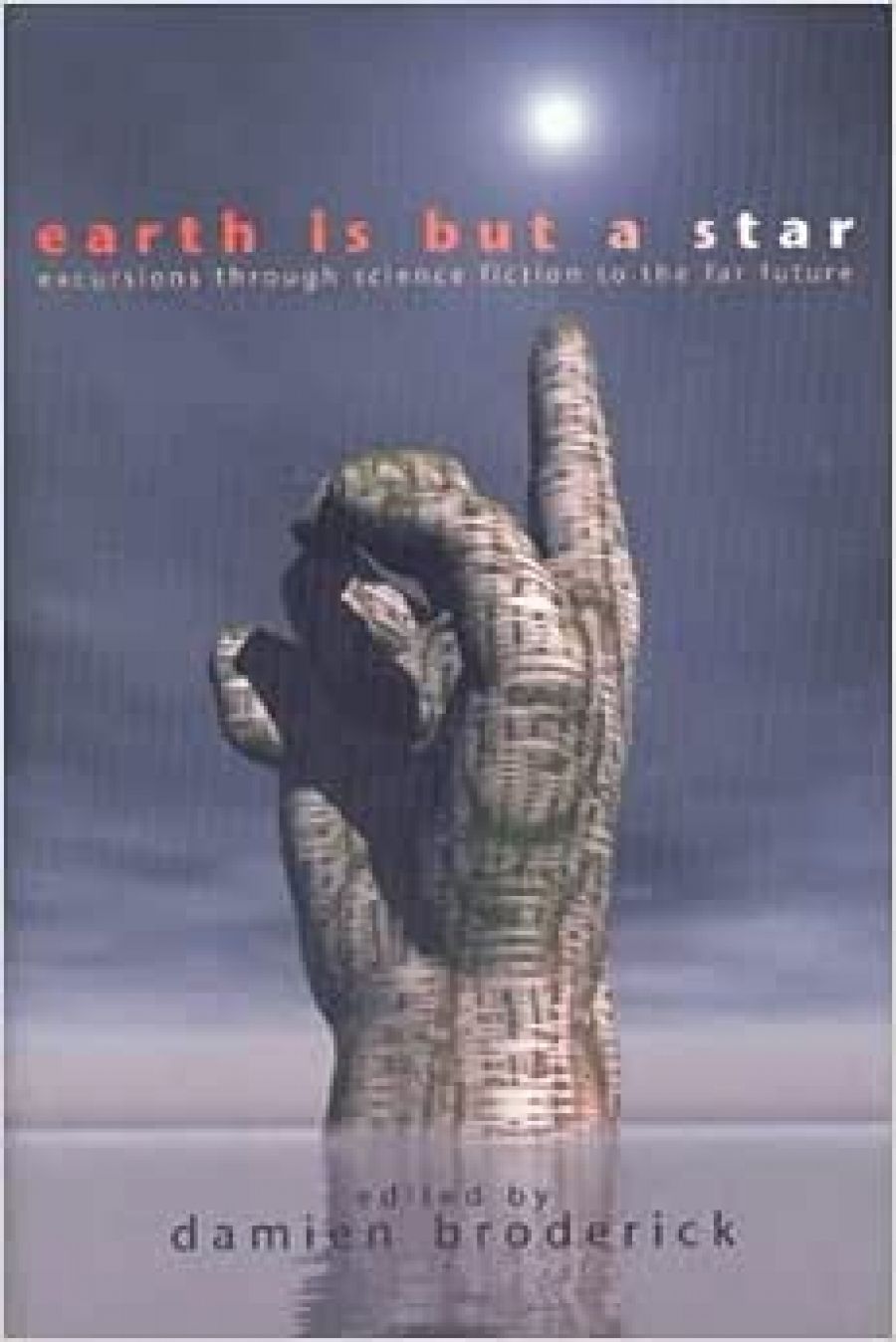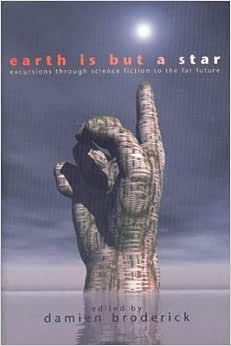
- Free Article: No
- Contents Category: Anthology
- Review Article: Yes
- Article Title: Alpha Is Not Omega
- Online Only: No
- Custom Highlight Text:
From its mix of fiction and criticism to the format of its contents page, this collection is clearly a follow-up to Helen Merrick and Tess Williams’s feminist science fiction anthology, Women of Other Worlds (1999). There are, however, major differences. Women emerged from a unique and unrepeatable event, a meeting of live minds at the twentieth WisCon Feminist SF Convention. It is wildly eclectic, often irreverent, ranging from recipes and e-mail debates on gender to full-blown critical articles on female fan culture, united only by the feminist perspective and the contributor’s presence at WisCon. Its reprints go back no further than 1986. The reader is encouraged to dip. In contrast, Earth is united by its ostensible theme, ‘far futures’, with reprints from as far back as the 1930s, but only ‘proper’ fiction – stories, excerpts from novels – and ‘proper’ critical pieces. The overall tone is sober if not solemn, and the single-minded thematic focus produces a strong similarity to Vegemite. Small dips are quite enough.
- Book 1 Title: Earth Is But a Star
- Book 1 Subtitle: Excursions through Science Fiction to the Far Future
- Book 1 Biblio: UWA Press, $34.95pb, 446pp
- Book 1 Cover Small (400 x 600):

Of the two strands, the criticism is the fresher, since nearly all of it seems to be previously unpublished. It ranges from Jo Walton’s and Walter Minkel’s brief discussions of a single text, to Alice K. Turner’s and Paul Voermans’s broader treatments of Cordwainer Smith and Paul J. McAuley, to discussions of two or more writers. Elizabeth Billinger on far futures in Arthur C. Clarke and Octavia Butler is deeper than Yvonne Rousseau’s piece on H.G. Wells and Helen de Guerry-Simpson, where Rousseau takes the familiar gambit of juxtaposing similar pieces by a well-known and an obscure writer. Up the density scale, Russell Blackford engages negative readings of Clarke’s well-known far future, The City and the Stars (1956), while Brian Stableford offers a magisterial perspective on the literary history of far-future SF texts. At sophistication’s apex, Stanislaw Lem offers a predictably stringent and high-flying critique of the far-future template, Olaf Stapledon’s Star Maker (1937), expounding its virtues with insight, but with enough confidence in its overall value to analyse and evaluate its flaws.
This judicial balance is rare. Many seem bent on defending either the sub-genre, or SF itself. Though Blackford refutes negative criticisms, he then offers a general defence rather than a competing analysis, and in its last paragraph Stableford’s Olympian survey descends with astonishing rapidity to abuse of ‘dwarfs, elves and … other maggots’ in ‘formulaic fantasy novels’. George Zebrowski does ask many of my questions about the sub-genre, but he too ends with a defence. In the long run, this protectiveness is more of a critical handicap. I, for one, am left asking plaintively: Did nobody consider reading The City and the Stars against the waning light of 1950s British imperialism? Did nobody want to compare Stapledon, for example, to near contemporaries like James Branch Cabell or E.R. Edison? Or to actually consider SF against that threatening Other of fantasy? How far, for example, is Jack Vance’s ‘Mazirian the Magician’ a seed narrative for some very good fantasy versions of magicianly defeat? And why does a clone-vat at the end make it science fiction? The nearest attempt at this is Michael Andre-Driussi’s article on Wolfe’s, Vance’s and Broderick’s novels. But it takes science fantasy as a known sub-genre, and concentrates on exhuming sources for invented names, a primary research tactic that leaves the critical reader little response but an expectant, ‘And so?’
If the critical roll-call contains a number of usual suspects for Australian SF and SF criticism – Blackford, Gillespie, Rousseau, John Clute, Stableford, Zebrowski – the fictional round-up is wide but sometimes predictable, from Stapledon past Clarke to Brian Aldiss, Gene Wolfe and John Brunner, on to A.E. van Vogt and Robert Silverberg. There appear to have been some procrustean selections, as with the very slight contribution from Gene Wolfe, but here a general problem surfaces. With so many old reprints, the name pieces, as from Clarke and Stapledon, are in danger of becoming hackneyed. This was my issue with Pamela Zoline’s well-known ‘The Heat Death of the Universe’, though it was pleasing to find a reprint from C. J. Cherryh’s Sunfall, and one of the more mannered pieces at that.
The anthology raised general questions for me as for Zebrowski. What value is far-future speculation? Setting aside the difficulty of needing characters for ‘anything like a story’ (Walton), given the enormous changes that wrong-foot speculative near-future writers from Flammarion (Minkel) to Neville Shute, how can we possibly extrapolate a ‘far’ future? Clearly, this raises the old dilemma: if it’s wholly strange, how can it be intelligible? and if not, how can it be wholly strange? The question raises serious concerns for post-colonial theorists like Stephen Greenblatt and Edward Said. It is adumbrated here by Zebrowski and Walton, but not really resolved. The fictions rather enforce Fredric Jameson’s contention that SF shows the weakness of our imagination, not its strength.
This is partly because the anthology makes a continual equation of ‘far future’ with the end of the Earth or of humanity, frequently conflating the two in a manner that underlines the problem of using older fiction, with explicably narrower cosmologies. Why should a far future have to equal the end of anything? Alpha is not Omega. The whole alphabet lies between. And surely a less anthropocentric vision might be expected, especially from SF, at a time when every new Hubble-image drives home our ludicrously tiny site on one planet in one star system on the flank of one star-coil in an ever-increasing galactic horde?
Rosaleen Love’s closing piece, ‘Star Drover,’ comes closest to this wider view. It is also one of the wittiest pieces and almost the only satirical one in the anthology, sending up current theory like Donna Haraway’s ‘Cyborg Manifesto’ along with the actual sub-genre, turning Clarke’s disembodied intelligence, Alvin, into a submersible, and Stapledon’s Star Maker into a drover whose dog flings fleas in ‘Magellanic clouds’. But Love also produces the only far future that is off Earth, beyond humanity, and outside some concern with carbon-based life. Is this conflation, this Alpha–Omega closed circuit, a lapse of the sub-genre, or a weakness in SF imagination overall? Does its very form, as fiction, impose cramping demands for plot and character, which are highlighted by a setting where these grow more unhelpful with every Hubble-shot? Is SF actually limited to the here and now, and this Earth alone?
I don’t think so, any more than I think the historical moment of SF is past. I do think the core of SF is not icons of spaceships or correct prophetic visions. It is the ability to think at the precise cusp of the known and the unknown, neither through a fixed historical moment, nor a million years into the unknowable. If spaceships now exist, is SF obsolete? No, because their SF depictions keep changing, somewhere just ahead of the ‘real.’ Any further ahead, and SF can only fossilise contemporary concerns. This anthology does itself no favours by putting so much about ends under a rubric that demands beginnings. It did, however, make me raise some very large questions, not only about far-future texts or the parameters of the whole genre, but about far futures in both concept and reality. It did not give me many answers. But, in the end, aren’t questions rather than answers what SF is all about?


Comments powered by CComment